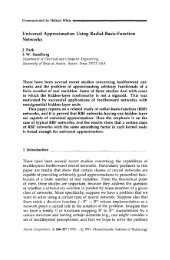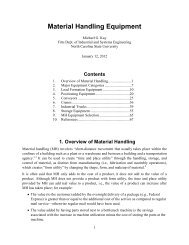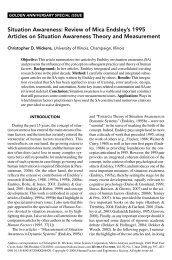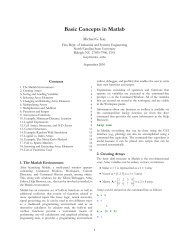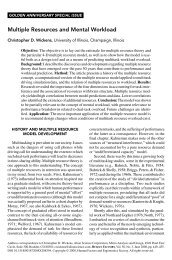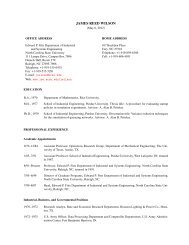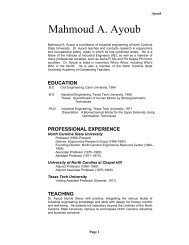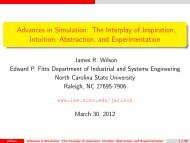Conventional Machining Methods for Rapid Prototyping
Conventional Machining Methods for Rapid Prototyping
Conventional Machining Methods for Rapid Prototyping
You also want an ePaper? Increase the reach of your titles
YUMPU automatically turns print PDFs into web optimized ePapers that Google loves.
2<br />
Z. Yang, R. A. Wysk, S. Joshi, M. C. Frank ,and J. E. Petrzelka<br />
rapid prototyping have made a substantial contribution to the soaring global markets <strong>for</strong><br />
quick-to-market, highly engineered products. The market <strong>for</strong> RP, consisting of all<br />
products and services globally, grew 16% to an estimated $1.141 billion in 2007,<br />
according to Wohlers Report 2008. Successful RP application areas include quoting,<br />
ergonomic studies, rapid tooling, visual aid <strong>for</strong> engineering, and functional models<br />
(Noorani 2006).<br />
In spite of the dramatic technology developments in RP during the last two decades,<br />
a majority of RP products still cannot be used <strong>for</strong> producing end-use parts. Technologies<br />
like <strong>Rapid</strong> Tooling (RT) and <strong>Rapid</strong> Manufacturing (RM) attempt to overcome many of<br />
the current limitations in the production of final end-use parts using RP technologies<br />
(Hopkinson, Hague et al. 2006). One of the major advantages of RP/RT/RM is the ability<br />
to create parts rapidly. <strong>Rapid</strong> manufacturing can be defined as the ability to manufacture<br />
an object, directly from CAD data input, without significant human intervention or skill.<br />
This procedure of trans<strong>for</strong>ming CAD data directly into final product is also referred to<br />
as direct manufacturing. From the literature, the common limitations <strong>for</strong> current RM<br />
processes are material variety and properties, processing speed, dimensional accuracy,<br />
surface finish, repeatability, geometry capability, and cost effectiveness (Grimm and<br />
Wohlers 2001; Ruffo and Hague 2007).<br />
From the manufacturing point of view, a large variety of processes are capable of<br />
producing RM products with one or several limitations mentioned above. Those<br />
processes include additive processes, such as stereolithography (SLA), Selective Laser<br />
Sintering (SLS), Fused Deposition Modeling (FDM), three-dimensional printing, Direct<br />
Metal Laser Sintering (DMLS), Laser Engineered Net Shaping (LENS) and Electron<br />
Beam Melting (EBM), and subtractive processes, such as CNC milling, CNC Wire EDM,<br />
etc. The limitations <strong>for</strong> current RM provide the general criteria <strong>for</strong> selecting<br />
manufacturing processes <strong>for</strong> RM applications. During the RM process selection<br />
procedure, the final product requirements are set as constraints <strong>for</strong> the process and the<br />
process efficiency/cost is set as the as the criterion <strong>for</strong> RM process candidates. Many RM<br />
processing candidates are eliminated because of they are incapable of meeting some of<br />
the common engineering product constraints, such as material, tolerance, and geometry.<br />
It appears that there are no dominating processes <strong>for</strong> making rapid prototyping parts<br />
and no universal RP process <strong>for</strong> all RM applications (Bártolo and Bidanda 2007). Most<br />
additive processes present no geometry limitations. The ability to produce almost endless<br />
geometric shapes and features using additive processes makes them a desirable candidate<br />
<strong>for</strong> nearly any geometry. However, some of other limitations, such as: material limits,<br />
processing speed, dimensional accuracy, surface finish, and cost effectiveness impose<br />
severe limits <strong>for</strong> the use of additive processes. Generally speaking, parts to be made using<br />
additive processes are typically constrained by material and dimensional accuracy<br />
(Hopkinson, Hague et al. 2006). On the other hand, subtractive processes are commonly<br />
limited by the geometry they can produce, but are capable of manufacturing products<br />
using a variety of materials and can fabricate products of high dimensional accuracy.<br />
In this paper, we present a variant of tradition subtractive manufacturing<br />
applications <strong>for</strong> CNC milling and CNC Wire EDM, and discuss how they can be utilized<br />
to obtain a part directly from Computer Aided Design (CAD) data without the use of any<br />
special tooling or significant process engineering. Section 2 provides a review of the<br />
literature on conventional machining process technologies <strong>for</strong> rapid prototyping. Section<br />
3 provides details on methodologies <strong>for</strong> conventional machining processes <strong>for</strong> rapid<br />
prototyping. Section 4 discusses the RM process selection criteria and compares several<br />
processes as RM tools. Section 5 discusses the economics of using conventional<br />
machining processes <strong>for</strong> rapid manufacturing..



